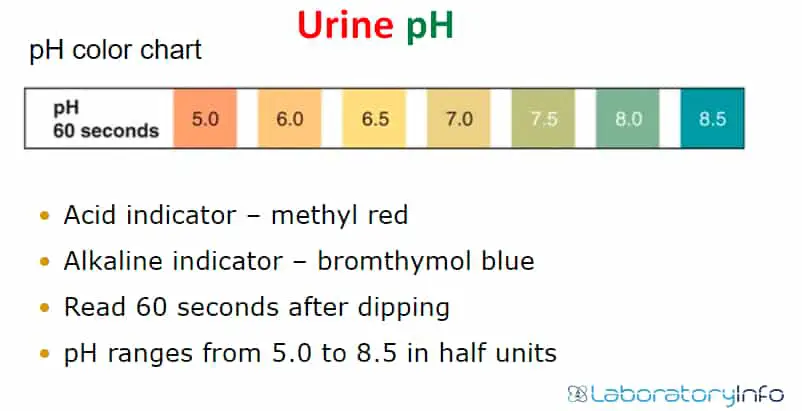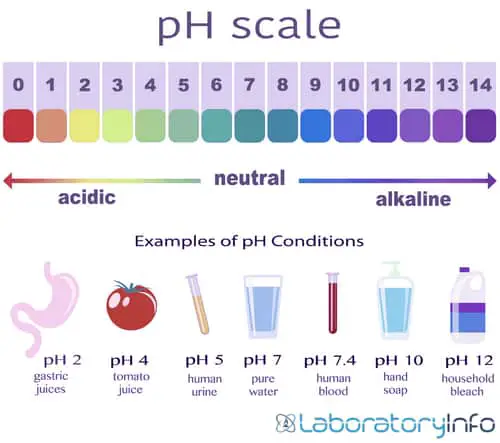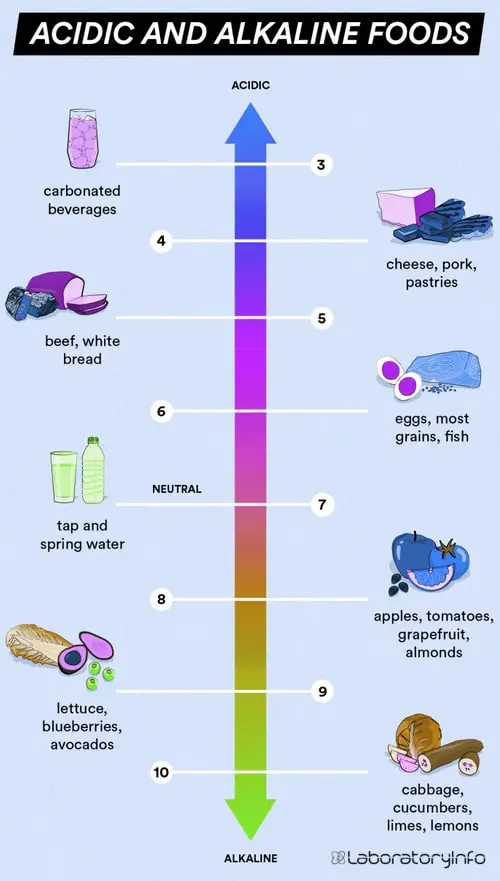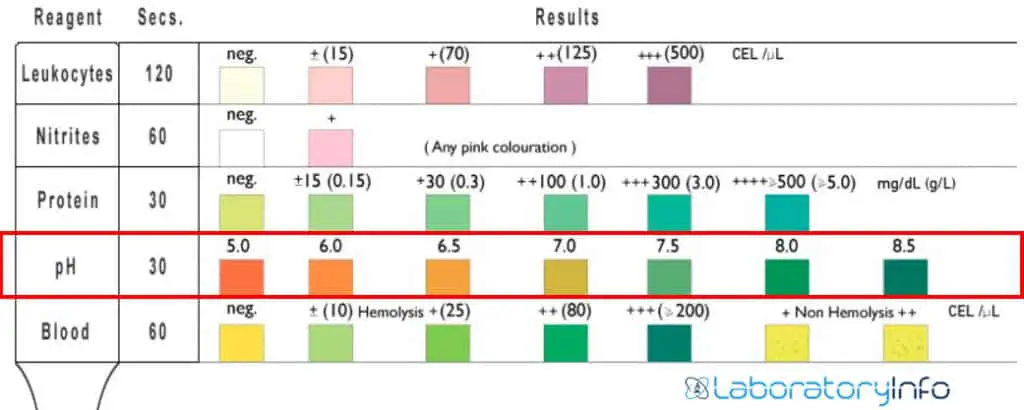Urine pH is the measure of acidity or basicity of urine. If the pH of urine is 8 or higher, it is indicated to be a basic while if it is 6 or lower, it will be indicated as acidic. The pH level tells us about the health conditions of a body.
Normal pH level and Range
The pH of urine is variable however, it may range from 4.5 – 8 (depending on the physiologic state), and it primarily depends upon the hydrogen ion concentration.
The kidney helps in the maintenance of pH by the excretion of hydrogen ions into the urine while reabsorbing the bicarbonate ions from the urine.

Abnormal pH level
If the hydrogen ion concentration is greater, the range shown on the scale will be 4.5 or less. The greater the concentration of hydrogen ions, the more it would be acidic.
The pH level depends upon the hydrogen ion concentration in urine.
But if the hydrogen ion concentration is low, the range shown on the scale will be 9.5 or greater. The lower the concentration of hydrogen, the more it would be basic.

Factor affecting pH
What a person eats daily plays a major role in affecting the acid-base balance. Food products having higher levels of hydrogen ions are considered to be acidic, and their consumption thus, makes the urine acidic.
While the food products having lower concentrations of hydrogen ions are considered to be basic, and having those products, considerably, increases the urinary pH.
Examples of acidic food items
- sodas
- beans
- high-sodium dressing
- certain grains
- some variety of cheese
- Foods rich in protein
Examples of basic food items
- Bread
- Legumes
- Vegetables
- Rice
- Fruit
- Some dairy products

Significance
Urine pH is very significant as it informs one about the health issues one may face. Different medical conditions have different effects on urinary pH. Some conditions tends to decrease it while others causes it to increase.
Medical Conditions
If the urine pH is high, it will be an indication of alkalinity. Following conditions could be the probable signs of alkalinity.
- Urinary tract infections (UTI)
- Kidney Stone
- Renal disorders
- Respiratory and metabolic alkalosis
The urine test can turn out to be alkaline if a person has had prolonged vomiting. By vomiting, a person gets rid of the stomach acid and thus it makes the body fluids more alkaline.
On the other hand, if the urine pH is low, it is a sign of acidity. Following conditions could be the probable signs of acidity.
- Starvation
- Diarrhea
- Pyrexia
- Respiratory and metabolic acidosis
| Alkaline Urine | Acidic Urine |
| Renal tubular acidosis | Dehydration |
| Alkaline drugs | Acidifying drugs |
| Diuretics (drugs usage) | Fever |
| Urinary tract infections | Gout |
| Vomiting | Diabetes |
| Metabolic and Respiratory Acidosis | Diet high in protein |
| – | Pulmonary Emphysema |
Urine Analysis
Urine analysis is a set of ‘’qualitative’’ and ‘’semi-quantitative’’ analysis performed on urine samples. A routine urine analysis includes a physical examination, chemical analysis, and microscopic examination
Physical Examination
The routine checkup of the physical characteristics of urine includes its color, odor, pH, turbidity, and specific gravity.
A test is carried out to detect the pH of urine. A simple procedure for its detection starts by taking a fresh sample of urine in a beaker. Then a pH paper strip is dipped in it. After a while, it is checked for color change
Chemical Examination of Normal Constituents
The chemical examination includes the testing of its organic and inorganic constituents.
- Organic constituents that encompass the urine pH are Uric acid and Creatinine.
- Different tests are undertaken for the detection of organic constituents.
- The test used for uric acid detection is Ammoniacal Silver Nitrate, and the test for the detection of creatinine is the picric acid test or Jaffe’s test.
- The inorganic constituents that affect the urine pH are Phosphates, Chlorides, and Calcium.
- The examination of inorganic constituents can be done by undertaking some of the tests such as the Sulkowitch test.
Microscopic Examination
The microscopic examination is a way to check and calculate the types of cast, crystals, cells, and microorganisms that are present in the urine.
Method to detect the pH of urine:
The observation of the pH of urine is very important as it tells us about the patient’s health condition. To keep a record, frequent analysis of urine pH is important.
Dipstick Analysis
The urine dipstick test is a rapid test that analyses the urine. A dipstick Is a thin plastic strip that contains small squares of different colors. The square on the dipstick contains specific chemicals that react differently when they come in contact with urine. Each color measures one specific quality of urine.
Step 1: Dip strip briefly.
Step 2: Withdraw the strip.
Step 3: Read the Results.

Treatment
It is significant for a healthy life to have a good diet, a nutritious life never comes without a healthy diet. The first step towards a vigorous lifestyle is to consume normal and fibrous food. Devouring a balanced diet for several days can bring about a significant change in the urine pH. Consumption of Vegetables and fruit should be increased.

Frequently Asked Questions:
Q1. What are the symptoms of acidic urine?
Ans. Having increased amount of uric acid leads to kidney stones and that results in painful urine, blood in urine and foul smelling urine.
Q2. What is the drug therapy for alkaline urine pH?
Ans. The following therapies can be used for curing the alkalinity of urine; Sulfa therapy, kanamycin, salicylate intoxication, etc.
Q3: How is urine pH measured?
Ans. A reagent test strip is usually used for pH measurement. In the reagent strips most commonly, has two indicators, one methyl red and the other bromthymol blue and it gives different colors in different urine pH.
Q4. How does vitamin C affect urine pH?
Ans. Vitamin C limits the bacterial growth by acidifying the urine. So, vitamin C actually functions as an acidifier.
Q5. Which organ is mainly involved in regulation of acid-base balance?
Ans. The major organs involved in the regulation of acid-base balance in the body are the kidneys.
Q6. Does bacteria survive in alkaline pH?
Ans. In high pH bacteria does not survive. However, some bacteria may survive in low pH.
References
- https://pubmed.ncbi.nlm.nih.gov/20407938/
- https://www.elsevier.com/books/T/A/9780702071676
- Textbook of Medical Biochemistry – U. Satyanarayana
- https://www.researchgate.net/profile/Malcolm-Brigden/publication/270904386_Urinalysis-Book_Chapter/links/54b98c4d0cf24e50e93dc7eb/Urinalysis-Book-Chapter.pdf
- https://www.sciencedirect.com/science/article/pii/B9781416066408000026
